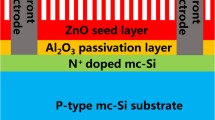Abstract
Fabrication of efficient, effective, and low-cost solar cell is still a challenging task using metal oxide semiconductors; in this work, γ-MnO2/α-Bi2O3 heterojunction was deposited on amorphous silicon substrate (a-Si) as a solar cell using vacuum thermal evaporation technique. XRD analysis of γ-MnO2/α-Bi2O3 showed a polycrystalline structure; SEM micrographs revealed that γ-MnO2 has quasi-spherical nanoparticles with a grain size average of 86.86 nm, while α-Bi2O3 has cauliflower-like microstructure with a grain size average of 250.71 nm; the optical bandgap were found to be 3.792 and 1.888 eV for γ-MnO2 and α-Bi2O3 respectively; I-V characteristic curve measurement was performed to evaluate the photovoltaic efficiency of MgF2/γ-MnO2/α-Bi2O3/a-Si solar cell and found to be 3.28%.







Similar content being viewed by others
References
Shyam, Ashutosh. Fabrication of high quality, low bandgap amorphous silicon & amorphous silicon germanium alloy solar cell by chemical annealing. (2011).
Gobrecht, H., et al. Über Untersuchungen an Wismutoxid-Aufdampfschichten. I. Herstellung sowie elektrische und optische Eigenschaften. physica status solidi (b) 33.2 (1969): 599–606.
Zhang J et al (2015) Preparation of novel YBiO3/Bi2O3 heterostructured composite with high visible light photocatalytic activity. Mater Express 5(4):336–342
Dolocan, V., and F. Iova. Optical properties of Bi2O3 thin films. physica status solidi (a) 64.2 (1981): 755–759.
Dolocan V (1978) Transmission spectra of bismuth trioxide thin films. Appl Phys 16(4):405–407
Leontie L et al (2001) Optical properties of bismuth trioxide thin films. Mater Res Bull 36(9):1629–1637
Leontie L, Caraman LM, Rusu GI (2000) On the photoconductivity of Bi∼ 2O∼ 3 in thin films. J Optoelectron Adv Mater 2(4):385–390
Leontie L et al (2002) Structural and optical characteristics of bismuth oxide thin films. Surf Sci 507:480–485
Tomchenko AA (2000) Structure and gas-sensitive properties of WO 3–Bi 2 O 3 mixed thick films. Sensors Actuators B Chem 68(1):48–52
Shimanoe K et al (1998) Bismuth oxide thin film as new electrochromic material. Solid State Ionics 113:415–419
Monnereau O et al (2003) Synthesis of Bi2O3 by controlled transformation rate thermal analysis: a new route for this oxide? Solid State Ionics 157(1):163–169
Gualtieri AF, Immovilli S, Prudenziati M (1997) Reduction process of RuO2 powder and kinetics of compound omega-Bi2O3 [J]. Powder Diffract 12(2):90–92
Shuk P et al (1996) Oxide ion conducting solid electrolytes based on Bi2O3. Solid State Ionics 89(3):179–196
Farid ul Islam AKM, Islam R, Khan KA (2005) Studies on the thermoelectric effect in semiconducting MnO2 thin films. J Mater Sci Mater Electron 16(4):203–207
Xu Y et al (2014) Electrodeposition of nanostructured MnO2 electrode on three-dimensional nickel/silicon microchannel plates for miniature supercapacitors. Mater Lett 126:116–118
Toupin M, Brousse T, Bélanger D (2002) Influence of microstucture on the charge storage properties of chemically synthesized manganese dioxide. Chem Mater 14(9):3946–3952
Wang X, Li Y (2002) Selected-control hydrothermal synthesis of α-and β-MnO2 single crystal nanowires. J Am Chem Soc 124(12):2880–2881
Cheng F et al (2006) Facile controlled synthesis of MnO2 nanostructures of novel shapes and their application in batteries. Inorg Chem 45(5):2038–2044
Suib SL (2008) Porous manganese oxide octahedral molecular sieves and octahedral layered materials. Acc Chem Res 41(4):479–487
Suib SL (2008) Structure, porosity, and redox in porous manganese oxide octahedral layer and molecular sieve materials. J Mater Chem 18(14):1623–1631
Espinal L et al (2012) Time-dependent CO2 sorption hysteresis in a one-dimensional microporous octahedral molecular sieve. J Am Chem Soc 134(18):7944–7951
Cheng Q et al (2010) Electrodeposition of MnO2 on carbon nanotube thin films as flexible electrodes for supercapacitors. Transactions of the Materials Research Society of Japan 35(2):369–372
Grundy AN, Hallstedt B, Gauckler LJ (2003) Assessment of the Mn-O system. Journal of phase equilibria 24(1):21–39
Hu C-C, Wang C-C (2003) Nanostructures and capacitive characteristics of hydrous manganese oxide prepared by electrochemical deposition. J Electrochem Soc 150(8):A1079–A1084
Hu C-C, Tsou T-W (2002) Capacitive and textural characteristics of hydrous manganese oxide prepared by anodic deposition. Electrochim Acta 47(21):3523–3532
Wan Y et al (2016) Magnesium fluoride electron-selective contacts for crystalline silicon solar cells. ACS Appl Mater Interfaces 8(23):14671–14677
Ammar T. Salih, Aus A. Najim, Malek A.H. Muhi, Kadhim R. Gbashi, Single material multilayer ZnS as anti-reflective coating for solar cell applications, Optics Communications, Vol 388, (2017) 84–89.
Acknowledgments
The authors gratefully acknowledge the Nanotechnology and Advanced Materials Research Centre, University of Technology, Baghdad, Iraq, for conducting all the tests.
Author information
Authors and Affiliations
Corresponding author
Rights and permissions
About this article
Cite this article
Najim, A.A., Muhi, M.A., Gbashi, K.R. et al. Synthesis of Efficient and Effective γ-MnO2/α-Bi2O3/a-Si Solar Cell by Vacuum Thermal Evaporation Technique. Plasmonics 13, 891–895 (2018). https://doi.org/10.1007/s11468-017-0585-2
Received:
Accepted:
Published:
Issue Date:
DOI: https://doi.org/10.1007/s11468-017-0585-2




